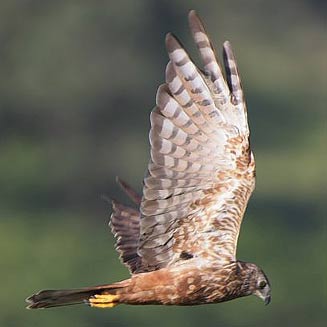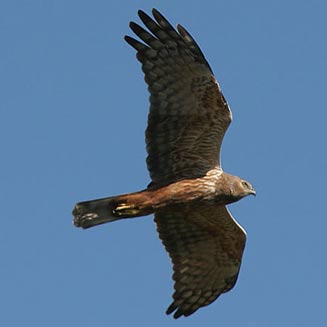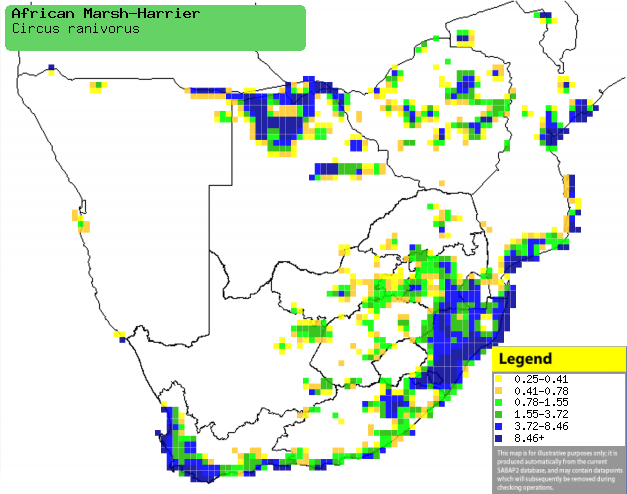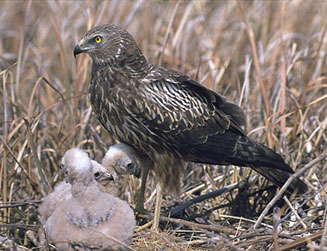|
Circus ranivorus (African
marsh-harrier)
Afrikaanse paddavreter [Afrikaans]; Afrikaanse vleivalk
[Afrikaans]; uMamhlangeni [Zulu]; ’Mankholi-kholi [South Sotho];
Nghotsana (also applied to Pallid harrier) [Tsonga]; Mmankgôdi, Phakwę
[Tswana]; Afrikaanse bruine kiekendief [Dutch]; Busard grenouillard
[French]; Afrikanische rohrweihe, Froschweihe [German];
Tartaranhăo-dos-pântanos [Portuguese]
Life
> Eukaryotes >
Opisthokonta
> Metazoa (animals) >
Bilateria >
Deuterostomia > Chordata >
Craniata > Vertebrata (vertebrates) > Gnathostomata (jawed
vertebrates) > Teleostomi (teleost fish) > Osteichthyes (bony fish) > Class:
Sarcopterygii (lobe-finned
fish) > Stegocephalia (terrestrial
vertebrates) > Tetrapoda
(four-legged vertebrates) > Reptiliomorpha > Amniota >
Reptilia (reptiles) >
Romeriida > Diapsida > Archosauromorpha > Archosauria >
Dinosauria
(dinosaurs) > Saurischia > Theropoda (bipedal predatory dinosaurs) >
Coelurosauria > Maniraptora > Aves
(birds) > Order: Falconiformes
> Family: Accipitridae
> Genus: Circus
 |
 |
| African marsh-harrier, Wildernis
National Park, South Africa. [photo Trevor Hardaker ©] |
African marsh-harrier, West Coast National Park,
South Africa. [photo Trevor Hardaker ©] |
Distribution and habitat
Occurs in sub-Saharan Africa, from Uganda, Kenya, eastern DRC, Tanzania, Zambia and Malawi to
South Africa. In southern Africa, it is locally
common in northern Botswana, the Caprivi Strip (Namibia), Zimbabwe, eastern
Mozambique and South Africa (excluding the arid Karoo and Kalahari). It generally
favours inland and coastal wetlands.
|
 |
|
Distribution of African marsh harrier in southern Africa,
based on statistical smoothing of the records from first SA Bird Atlas
Project (©
Animal Demography unit, University of
Cape Town; smoothing by Birgit Erni and Francesca Little). Colours range
from dark blue (most common) through to yellow (least common).
See here for the latest distribution
from the SABAP2. |
Movements and migrations
Breeding adults are largely sedentary, although
juveniles may travel far from their parent's territory once they
become independent.
Food
It mainly eats small mammals, doing most of its hunting
from the air on very windy days, rapidly diving to the ground to ambush its prey.
It may attempt to catch birds aerially, but it is much more unsuccessful
than when it hunts mammals. The following food items have been recorded
in its diet:
Breeding
- Monogamous, highly territorial solitary nester, in fact in intense
territorial disputes an individual may lock talons with another bird and
spiral to the ground. The pair bond is strong, as pairs may breed in the same
territory over many breeding seasons.
- The nest (see image below) is built by both sexes, consisting of a
shallow platform of grass and reed stems on a platform of sticks. This
structure is
typically placed in reeds near or over water, often in a large wetland; it
may also position it in sedges, fynbos or even in a wheat field adjacent to a
wetland.
 |
|
|
African marsh harrier at its nest with chicks,
Bronkhorstspruit area, South Africa. [photo Warwick Tarboton ©] |
|
- Egg-laying season is year-round, peaking from June-November.
- It lays 2-5 eggs, which are incubated solely by the female for about
31-33 days, while the male feeds her at the nest.
- At first the chicks are brooded and defended by the female, while the
male feeds both her and the chicks. Later she joins the male in hunting, as
after the chicks reach 18-20 days old they can defend themselves by lying on
their backs and kicking. The young leave the nest at about 38-45 days old,
becoming fully independent roughly 29-45 days later.
Threats
Not threatened globally, but Endangered in Namibia
and Vulnerable in South Africa, as there has been an estimated 20%
population loss due to wetland loss and fires during the breeding season.
References
-
Hockey PAR, Dean WRJ and Ryan PG 2005. Roberts
- Birds of southern Africa, VIIth ed. The Trustees of the John Voelcker
Bird Book Fund, Cape Town.
|
